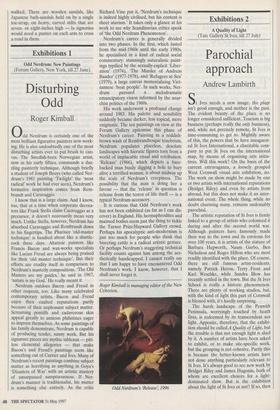Exhibitions 2
A Quality of Light (Tate Gallery St Ives, till 27 July)
Parochial approach
Andrew Lambirth
St Ives needs a new image: the plage isn't good enough, and neither is the past. The evident beauty of the place is no longer considered sufficient. Tourism is big business (perhaps really the only business), and, while not precisely remote, St Ives is time-consuming to get to. Mightily aware of this, the powers that be have inaugurat- ed St Ives International, a charitable com- pany to put St Ives on the international map, by means of organising arts initia- tives. Will this work? On the basis of the current extravaganza, a loosely grouped West Cornwall visual arts exhibition, no. The work on show might be made by one or two artists with international reputations (Bridget Riley) and even by artists from abroad, but this does not make it an inter- national event. The whole thing, while no doubt charming many, remains undeniably parochial.
The artistic reputation of St Ives is firmly linked to a group of artists who colonised it during and after the second world war. Although painters have famously made their way to the town and its environs for over 100 years, it is artists of the stature of Barbara Hepworth, Naum Garbo, Ben Nicholson and Roger Hilton who are most readily identified with the place. Of course, there are still famous artist-residents, namely Patrick Heron, Terry Frost and Karl Weschke, while Sandra Blow has recently settled in the town. But the St Ives School is really a historic phenomenon. There are plenty of working studios, but, with the kind of light this part of Cornwall is blessed with, it's hardly surprising.
The harsh landscape of the Penwith Peninsula, worryingly touched by heath fires, is redeemed by its transcendent sea light. Apposite, therefore, that the exhibi- tion should be called A Quality of Light, but the trouble is that not enough light is shed by it. A number of artists have been asked to exhibit, or to make site-specific work, but the grouping is not cohesive. Partly this is because the better-known artists have not done anything particularly relevant to St Ives. It's always good to see new work by Bridget Riley and James Hugonin, both of whom are excellent choices for a light- dominated show. But is the exhibition about the light of St Ives or not? If so, then to validate them for inclusion, the works by Riley and Hugonin should have been paint- ed in the town. They were not. I doubt if they were even made with St Ives in mind. It's reassuring to know that Bridget Riley enjoyed childhood holidays in the area and has fond memories of it, but this is not enough. And James Hugonin is very specif- ically the painter of North Northumbrian light. Why is Patrick Heron, a painter of the local light if ever there was one, and an international celebrity, not included?
There is far too prevalent a curatorial tendency to find an idea and then make the art (or the artists) fit into it. This is the wrong way round: the art should suggest the exhibition. The best work in this show is by Glen Onwin — a marvellous installa- tion in Geevor Tin Mine — which has only the most tangential connection with the subject of light. Even the artist sounds apologetic when he says it's about concep- tual light; one must think of the miners emerging from the pit into daylight or night. In fact, Onwin's intervention refers to the methods of separating tin ore from crushed rock, using water and vibrating tables. A terraced installation of square and kite-shaped tanks (one black with coal, another white with china clay, the next red with oxide of tin ore, the last yellow with ochre), overlooked by a giant pelican, cele- brates a mystical meeting of industry and alchemy. It's unusual and impressive.
The enterprise as a whole appears ill- fated. Perhaps the most appropriate choice of artist was Roger Ackling, who makes images using a hand lens and the sun's rays. His burnt offerings are usually poetic and beautiful: however, the work on card he made on Porthmeor Beach, showing at the St Ives Tate with a Bernard Leach pot, looks pedestrian in comparison. Ron Haselden's neon sculpture of a diver has a monumentality that is wasted by sitting it on the edge of an old sluicing pool at Hayle. (It was originally intended for Land's End where it would have looked spectacular.) Mona Hatoum's installation of caged lightbulbs, like a torture chamber or the freakishly wired perimeter fence of a detention camp, is a variation of a work she made for San Francisco, and looks out of place in Newlyn Art Gallery. Even the camera obscura, galvanometer and Morse- code project set up in Porthcurno by Paul Ramirez Jonas (to echo this early telecom- munications site), seems more like a com- puter game than anything else.
Obviously St Ives should not simply become a museum. What about the Atlantic embrace? Mark Rothko visited in the 1950s, so why not invite a bunch of the best (whoever decides these things) Ameri- can artists to come over for a season and make art in the town? That would surely liven things up. It's also deeply ironic that apart from the light (and the relative cheapness of living) one of the main rea- sons artists go to live in St Ives in the first place is to escape from other people. What Ron Haselden's The Diver, 1997 of their privacy? Put St Ives on the map even more, and you might well be killing the goose that lays the golden eggs.



































































 Previous page
Previous page